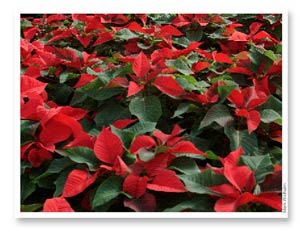6/15/2009
Producing Perfect Poinsettias
Dr. Tom Boerth

At its 14-acre facility in Winter Garden, Florida, Knox Nursery produces a year-round poinsettia program, growing 1.5 million rooted liners for its primary customers, Syngenta and the Paul Ecke Ranch. In addition, the company produces 150,000 finished pots for the local market. The entire program is grown in heated greenhouses.
With poinsettias on the property 47 to 49 weeks of the year, Knox’s general manager Steve Mullen must deal with rooting the cuttings in Florida’s brutally hot summer weather. Though poinsettias are tropical plants that thrive in a hot, humid environment, they root best in moderate temperatures. “Our challenge lies in keeping the greenhouses cool enough for the plants to remain turgid and healthy enough to root,” Steve says.
In order to control Pythium, Steve incorporates Rootshield (Bioworks Inc.) into their soil at a rate of 1.25 lbs. per yd. Within the first three to four days after sticking the cuttings, Knox applies a drench of Citation (Syngenta) at a rate of 2.66 oz. per 100 gal. This aids in controlling fungus gnat larvae and is an important step in their poinsettia production process.
In the first few days after Knox receives cuttings, they’re extremely susceptible to erwinia, a bacterial soft rot that enters the plant through openings caused by injury or bruising. “Until the plants are calloused, they are vulnerable to erwinia,” Steve notes. “The condition thrives in the warm, humid Florida summer, and there’s really nothing you can use to prevent it or control it. The protocol is, if you see a plant affected by erwinia, you just remove it from the area.”
Steve follows an aggressive mist program to combat erwinia. Within the first 24 hours, he makes an application of CapSil spray adjuvant (Aquatrols) to help poinsettia plants regain their turgidity. “CapSil tends to break down the droplet size on the leaf, providing better coverage,” says Steve. “It really helps reinvigorate the plants and starts them on the process of callusing.” After they become callused, he says, the cuttings are better able to withstand erwinia and other diseases.
Finishing out the season
After the first week or so in the greenhouse, applications revolve around growth regulators. Steve applies up to three PGR treatments to control growth during the rooting process. He also makes an insecticide application for whitefly control. There are usually no more fungicide applications to the crop until one to two days prior to shipping. At that time, Steve uses Decree (Arysta Lifescience Corp.) at a rate of 1 tsp. per gal. as a spray to control botrytis that could possibly occur during shipping. Knox’s rooting crop time for most of the varieties they produce is 28 days during the summer and 35 days in spring.
This regime that Knox employs is interrupted only if and when the crop is suffering from a soil-borne fungal infestation that isn’t controlled by Rootshield. In this case, Steve applies a drench of Cleary’s (Cleary Chemical Corp.) at 15 oz. per 100 gal. along with Truban (Scotts) at 5 oz. per 100 gal. “This isn’t a scheduled part of our program,” Steve says. “Rather, it’s a standby formulation in case something unusual pops up.”
Dr. Tom Boerth is manager of research and development for Aquatrols.